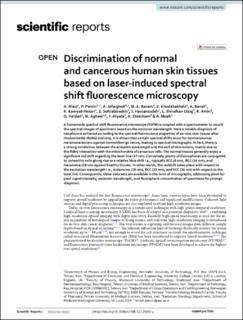Discrimination of normal and cancerous human skin tissues based on laser‑induced spectral shift fluorescence microscopy
| dc.contributor.author | Niazi, Azadeh | |
| dc.contributor.author | Parvin, Parviz | |
| dc.contributor.author | Jafargholi, Amir | |
| dc.contributor.author | Basam, M. A. | |
| dc.contributor.author | Khodabakhshi, Zahra | |
| dc.contributor.author | Bavali, Ali | |
| dc.contributor.author | Kamyab Hesari , Kambiz | |
| dc.contributor.author | Sohrabizadeh, Zahra | |
| dc.contributor.author | Hassanzadeh, Tara | |
| dc.contributor.author | Shirafkan Dizaj, Leyla | |
| dc.contributor.author | Amiri, Reza | |
| dc.contributor.author | Heidari , Omid | |
| dc.contributor.author | Aghaei, Mohammadreza | |
| dc.contributor.author | Atyabi, F. | |
| dc.contributor.author | Ehtesham, A. | |
| dc.contributor.author | Moafi, A. | |
| dc.date.accessioned | 2023-01-24T09:54:01Z | |
| dc.date.available | 2023-01-24T09:54:01Z | |
| dc.date.created | 2022-12-08T09:36:43Z | |
| dc.date.issued | 2022 | |
| dc.identifier.issn | 2045-2322 | |
| dc.identifier.uri | https://hdl.handle.net/11250/3045737 | |
| dc.description.abstract | A homemade spectral shift fluorescence microscope (SSFM) is coupled with a spectrometer to record the spectral images of specimens based on the emission wavelength. Here a reliable diagnosis of neoplasia is achieved according to the spectral fluorescence properties of ex-vivo skin tissues after rhodamine6G (Rd6G) staining. It is shown that certain spectral shifts occur for nonmelanoma/melanoma lesions against normal/benign nevus, leading to spectral micrographs. In fact, there is a strong correlation between the emission wavelength and the sort of skin lesions, mainly due to the Rd6G interaction with the mitochondria of cancerous cells. The normal tissues generally enjoy a significant red shift regarding the laser line (37 nm). Conversely, plenty of fluorophores are conjugated to unhealthy cells giving rise to a relative blue shift i.e., typically SCC (6 nm), BCC (14 nm), and melanoma (19 nm) against healthy tissues. In other words, the redshift takes place with respect to the excitation wavelength i.e., melanoma (18 nm), BCC (23 nm), and SCC (31 nm) with respect to the laser line. Consequently, three data sets are available in the form of micrographs, addressing pixel-by-pixel signal intensity, emission wavelength, and fluorophore concentration of specimens for prompt diagnosis. | en_US |
| dc.language.iso | eng | en_US |
| dc.publisher | Nature | en_US |
| dc.rights | Navngivelse 4.0 Internasjonal | * |
| dc.rights.uri | http://creativecommons.org/licenses/by/4.0/deed.no | * |
| dc.title | Discrimination of normal and cancerous human skin tissues based on laser‑induced spectral shift fluorescence microscopy | en_US |
| dc.title.alternative | Discrimination of normal and cancerous human skin tissues based on laser‑induced spectral shift fluorescence microscopy | en_US |
| dc.type | Peer reviewed | en_US |
| dc.type | Journal article | en_US |
| dc.description.version | publishedVersion | en_US |
| dc.source.volume | 12 | en_US |
| dc.source.journal | Scientific Reports | en_US |
| dc.source.issue | 1 | en_US |
| dc.identifier.doi | 10.1038/s41598-022-25055-y | |
| dc.identifier.cristin | 2090463 | |
| cristin.ispublished | true | |
| cristin.fulltext | original | |
| cristin.qualitycode | 1 |

